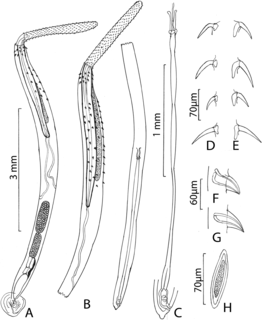
Digenea is a class of trematodes in the Platyhelminthes phylum, consisting of parasitic flatworms with a syncytial tegument and, usually, two suckers, one ventral and one oral. Adults commonly live within the digestive tract, but occur throughout the organ systems of all classes of vertebrates. Once thought to be related to the Monogenea, it is now recognised that they are closest to the Aspidogastrea and that the Monogenea are more closely allied with the Cestoda. Around 6,000 species have been described to date.

Helminthology is the study of parasitic worms (helminths). The field studies the taxonomy of helminths and their effects on their hosts.

Plagiorchiida is a large order of trematodes, synonymous to Echinostomida. They belong to the Digenea, a large subclass of flukes. This order contains relatively few significant parasites of humans.
Arhythmacanthidae is a family of parasitic worms from the order Echinorhynchida.

Cavisomidae are a family of parasitic worms from the order Echinorhynchida.
Diplosentidae is a family of parasitic worms from the order Echinorhynchida.

Pomphorhynchidae is a family of parasitic worms from the order Echinorhynchida.
Hypoechinorhynchidae is a family of parasitic worms from the order Echinorhynchida.

Illiosentidae is a family of parasitic worms from the order Echinorhynchida.

Rhadinorhynchidae is a family of parasitic worms from the order Echinorhynchida.

Opisthorchiidae is a family of digenean trematodes. Opisthorchiidae have cosmopolitan distribution.

Mazocraeidea is an order in the subclass Polyopisthocotylea within class Monogenea.

Opecoelidae is a family of trematodes. It is the largest digenean family with over 90 genera and nearly 900 species, almost solely found in marine and freshwater teleost fishes. It was considered by Bray et al. to belong in the superfamily Opecoeloidea Ozaki, 1925 or the Brachycladioidea Odhner, 1905.

Pseudorhabdosynochus is a genus of monopisthocotylean monogeneans, included in the family Diplectanidae. The type-species of the genus is Pseudorhabdosynochus epinepheli .

The Diplectanidae are a family of monopisthocotylean monogeneans. They are all parasitic on the gills of fish. Diplectanids are small animals, generally around 1 mm in length. As parasites, they can be extremely numerous, up to several thousand on an individual fish.

Satyu Yamaguti was a Japanese parasitologist, entomologist, and helminthologist. He was a specialist of mosquitoes and helminths such as digeneans, monogeneans, cestodes, acanthocephalans and nematodes. He also worked on the parasitic crustaceans Copepoda and Branchiura. Satyu Yamaguti wrote more than 60 scientific papers and, more importantly, several huge monographs which are still in use by scientists all over the world and were cited over 1,000 times each.

The Capsalidae is a family of monopisthocotylean monogeneans, which includes about 200 species.

Microcotylidae is a family of polyopisthocotylean monogeneans. All the species in this family are parasitic on fish.
Aephnidiogenidae is a family of trematodes in the order Plagiorchiida.
Sauracanthorhynchus is a genus of thorny-headed worms. It is the only genus in the family Sauracanthorhynchidae in the order Echinorhynchida. It contains a single species Sauracanthorhynchus sphenomorphicola. It was found the intestines of the skink Sphenomorphus granulatus. The host is found from the Huon Peninsula to Milne Bay Province, and the adjacent D'Entrecasteaux Islands of Fergusson, and Normamby. The reported range of the parasite is restricted to Milne Bay Province, Papua New Guinea. The genus is named after the order of its host, and the species is named after the genus of its host.














